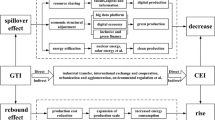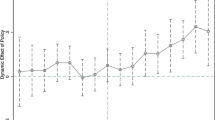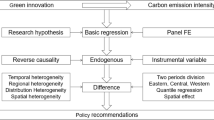Abstract
With the introduction of national carbon neutrality targets, carbon emission reduction actions in developed countries have become a hot topic as part of the international community’s drive to take action to mitigate climate change. Carbon emission efficiency is an important indicator that can be used to measure progress toward carbon emission reduction targets. The relationship between green technology innovation and carbon emission efficiency has not been adequately studied, and the transmission mechanism is not yet clear. Based on the above research gaps, taking 32 developed countries that have proposed carbon neutral targets as research samples, this paper used spatial econometric models to explore the impact of green technology innovation on carbon emission efficiency and adopted spatial mediation model and spatial moderation model to analyze the transmission effects of economic development, urbanization, and financial development on environment-related green technology and carbon emission efficiency. This paper aimed to provide a policy basis for developed countries to mitigate carbon emissions and achieve carbon neutrality goals as soon as possible. The following results were obtained: (1) Luxembourg, Norway, and Switzerland were found to be efficient in terms of carbon emissions, while most developed countries were in an inefficient state. (2) Environment-related green technology innovation significantly improved carbon emission efficiency. (3) Economic development and urbanization had a mediating role on green technology innovation and carbon emission efficiency. In other words, green technology innovation could have an indirect impact on carbon emission efficiency by influencing economic development and urbanization. (4) Financial development could positively moderate the sensitivity of carbon emission efficiency to green technology innovation. Improving the level of green technology innovation is one way to improve carbon emission efficiency, and the mediating effect of economic development and urbanization can be used as a focus point to improve carbon emission efficiency. The pressure of carbon emission reduction can be moderated by finance development. The results of this study provide theoretical support that will assist developed countries in achieving their carbon neutrality targets.




Similar content being viewed by others
Data availability
Data and materials are available from the authors upon request.
References
Abolhosseini S, Heshmati A, Altmann J (2014) The effect of renewable energy development on carbon emission reduction: An empirical analysis for the EU-15 countries. IZA Discuss Pap 7989
Acemoglu D, Aghion P, Bursztyn L, Hemous D (2012) The environment and directed technical change. Am Econ Rev 102(1):131–166
Acheampong A, Amponsah M, Boateng E (2020) Does financial development mitigate carbon emissions? Evidence from heterogeneous financial economies. Energy Econ 88:104768
Aigner D, Lovell C, Schmidt P (1977) Formulation and estimation of stochastic frontier production function models. J Econom 6(1):21–37
Amin A, Aziz B, Liu X (2020) The relationship between urbanization, technology innovation, trade openness, and CO2 emissions: Evidence from a panel of Asian countries. Environ Sci Pollut Res 27(28):35349–35363
Apaydın A, Ocakoğlu F (2020) Response of the Mogan and Eymir lakes (Ankara, Central Anatolia) to global warming: Extreme events in the last 100 years. J Arid Environ 183:104299
Bekhet H, Latif N (2018) The impact of technological innovation and governance institution quality on Malaysia’s sustainable growth: Evidence from a dynamic relationship. Technol Soc 54:27–40
Blackburn K, Hung V (1998) A theory of growth, financial development and trade. Econ 65:107–124
Cai B, Guo H, Ma WZ, Dhakal S, Cao L (2019) Benchmarking carbon emissions efficiency in Chinese cities: A comparative study based on high-resolution gridded data. Appl Energy 242:994–1009
Capello R, Lenzi C (2014) Spatial heterogeneity in knowledge, innovation, and economic growth nexus: Conceptual reflections and empirical evidence. J Reg Sci 54(2):186–214
Charnes A, Cooper W, Rhodes E (1978) Measuring the efficiency of decision making units. Eur J Oper Res 2(6):429–444
Chen J, Wang L, Li Y (2020) Natural resources, urbanization and regional innovation capabilities. Resour Policy 66:101643
Cheng K (2009) Urbanization, technological innovation and economic growth——An empirical study based on the mediating effect of innovation. Stat Res 26(5):40–46 (in Chinese)
Cheng K (2010) The mechanism and evidence of urbanization promoting technological innovation. Sci Res Manage 31(02):26–34 (in Chinese)
Cheng L, Zhu J, Abraham J, Trenberth K, Fasullo J, Zhang B, Yu F, Wan L, Chen X, Song X (2019) 2018 continues record global ocean warming. Sci Press 36:249–252
Cui Q, Li Y (2015) An empirical study on the influencing factors of transportation carbon efficiency: Evidences from fifteen countries. Appl Energy 141:209–217
Daniel B, Muhammad S, David R, Sahbi F (2018) How economic growth, renewable electricity and natural resources contribute to CO2 emissions? Energy Policy 113:356–367
Deng Y, You D, Wang J (2019) Optimal strategy for enterprises’ green technology innovation from the perspective of political competition. J Clean Prod 235:930–942
Ding L, Yang Y, Wang W, Calin A (2019) Regional carbon emission efficiency and its dynamic evolution in China: A novel cross efficiency-malmquist productivity index. J Clean Prod 241:118260
Dong F, Long R, Bian Z, Xu X, Yu B, Wang Y (2017) Applying a Ruggiero three-stage super-efficiency DEA model to gauge regional carbon emission efficiency: Evidence from China. Nat Hazards 87(3):1453–1468
Dong F, Li Y, Qin C, Sun J (2021a) How industrial convergence affects regional green development efficiency: A spatial conditional process analysis. J Environ Manage 300:113738
Dong F, Li Y, Zhang X, Zhu J, Zheng L (2021b) How does industrial convergence affect the energy efficiency of manufacturing in newly industrialized countries? Fresh evidence from China. J Clean Prod 316:128316
Dong F, Li Y, Gao Y, Zhu J, Qin C, Zhang X (2022a) Energy transition and carbon neutrality: Exploring the non-linear impact of renewable energy development on carbon emission efficiency in developed countries. Resour Conserv Recycl 177:106002
Dong F, Li Y, Li K, Zhu J, Zheng L (2022b) Can smart city construction improve urban ecological total factor energy efficiency in China? Fresh evidence from generalized synthetic control method. Energy 241:122909
Du K, Li P, Yan Z (2019) Do green technology innovations contribute to carbon dioxide emission reduction? Empirical evidence from patent data. Technol Forecasting Soc Change 146:297–303
Feng Y, Wang X, Liang Z (2021) How does environmental information disclosure affect economic development and haze pollution in Chinese cities? The mediating role of green technology innovation. Sci Total Environ 775:145811
Gao P, Yue S, Chen H (2021) Carbon emission efficiency of China’s industry sectors: From the perspective of embodied carbon emissions. J Clean Prod 283:4655
Hanif I (2018) Impact of economic growth, nonrenewable and renewable energy consumption, and urbanization on carbon emissions in Sub-Saharan Africa. Environ Sci Pollut Res 25(15):15057–15067
Hannes W, Dennis H (2015) Trajectories of efficiency measurement: a bibliometric analysis of DEA and SFA. Eur J Oper Res 240(1):1–21
Hao Y, Ba N, Ren S, Wu H (2021) How does international technology spillover affect China’s carbon emissions? A new perspective through intellectual property protection. Sustain Prod Consump 25:577–590
Hasan I, Tucci C (2010) The innovation–economic growth nexus: Global evidence. Res Policy 39(10):1264–1276
Huang Z, Liao G, Li Z (2019) Loaning scale and government subsidy for promoting green innovation. Technol Forecast Soc Change 144:148–156
Iyer G, Clarke L, Edmonds J, Fawcett A, Fuhrman J, McJeon H, Waldhoff S (2021) The role of carbon dioxide removal in net-zero emissions pledges. Energy Clim Change 2:100043
Jiang R, Zhou Y, Li R (2018) Moving to a low-carbon economy in China: Decoupling and decomposition analysis of emission and economy from a sector perspective. Sustainability 10(4):978
Koondhar M, Shahbaz M, Ozturk I, Randhawa A, Kong R (2021) Revisiting the relationship between carbon emission, renewable energy consumption, forestry, and agricultural financial development for China. Environ Sci Pollut Res 28:45459–45473
Kumar S, Managi S (2009) Energy price-induced and exogenous technological change: Assessing the economic and environmental outcomes. Resour Energy Econ 31(4):334–353
Lan F, Sun L, Pu W (2021) Research on the influence of manufacturing agglomeration modes on regional carbon emission and spatial effect in China. Econ Modell 96:346–352
Li D (2021) Green technology innovation path based on blockchain algorithm. Sustain Comput Inf Syst 31:100587
Li T, Liao G (2020) The heterogeneous impact of financial development on green total factor productivity. Front Energy Res 8:29
Li D, Xu H, Zhang S (2018) Financial development, technological innovation and carbon emission efficiency: a theoretical and empirical study. Explor Econ Issues 2:169–174 (in Chinese)
Lin B, Du K (2015) Modeling the dynamics of carbon emission performance in China: a parametric Malmquist index approach. Energy Econ 49:550–557
Liu Y, Dong F (2021) How technological innovation impacts urban green economy efficiency in emerging economies: A case study of 278 Chinese cities. Resour Conserv Recycl 169:105534
Liu Y, Dong F (2022) What are the roles of consumers, automobile production enterprises, and the government in the process of banning gasoline vehicles? Evidence from a tripartite evolutionary game model. Energy 238:122004
Liu Y, Zhao G, Zhao Y (2016) An analysis of Chinese provincial carbon dioxide emission efficiencies based on energy consumption structure. Energy Policy 96:524–533
Maradana R, Pradhan R, Dash S, Gaurav K, Jayakumar M, Chatterjee D (2017) Does innovation promote economic growth? Evidence from European countries. J Innov Entrepreneur 6(1):1–23
Meierrieks D (2014) Financial development and innovation: Is there evidence of a Schumpeterian finance-innovation nexus? Ann Econ Finance 15(2):61–68
Moutinho V, Madaleno M, Macedo P (2020) The effect of urban air pollutants in Germany: eco-efficiency analysis through fractional regression models applied after DEA and SFA efficiency predictions. Sustain Cities Soc 59:102204
Pan Y, Dong F (2022) Design of energy use rights trading policy from the perspective of energy vulnerability. Energy Policy 160:112668
Paramati S, Mo D, Huang R (2021) The role of financial deepening and green technology on carbon emissions: Evidence from major OECD economies. Finance Res Lett 41:101794
Razzaq A, Wang Y, Chupradit S, Suksatan W, Shahzad F (2021) Asymmetric inter-linkages between green technology innovation and consumption-based carbon emissions in BRICS countries using quantile-on-quantile framework. Technol Soc 66:101656
Ren X, Sha Y, Shi Z, Liu X (2021) Response of summer extreme precipitation over East Asia during the mid-Holocene versus future global warming. Glob Planet Change 197:103398
Sephton P, Mann J (2013) Further evidence of an Environmental Kuznets Curve in Spain. Energy Econ 36:177–181
Shang J, Wang Z, Li L, Chen Y, Li P (2018) A study on the correlation between technology innovation and the new-type urbanization in Shaanxi province. Technol Forecast Soc Change 135:266–273
Shao X, Zhong Y, Liu W, Li (2021) Modeling the effect of green technology innovation and renewable energy on carbon neutrality in N-11 countries? Evidence from advance panel estimations. J Environ Manage 296:113189
Sun W, Huang C (2020) How does urbanization affect carbon emission efficiency? Evidence from China. J Clean Prod 272:122828
Sun C, Liu X, Li A (2018) Measuring unified efficiency of Chinese fossil fuel power plants: Intermediate approach combined with group heterogeneity and window analysis. Energy Policy 123:8–18
Svirydzenka K (2016) Introducing a new broad-based index of financial development. International Monetary Fund
Tadesse S (2002) Financial architecture and economic performance: international evidence. Financ Dev Technol 11:429–454
Tang C, Tan E (2013) Exploring the nexus of electricity consumption, economic growth, energy prices and technology innovation in Malaysia. Appl Energy 104:297–305
Tone K (2001) A slacks-based measure of efficiency in data envelopment analysis. Eur J Oper Res 130(3):498–509
Toshiyuki S, Yan Y (2018) Measuring energy usage and sustainability development in Asian nations by DEA intermediate approach. J Econ Struct 7(1):1–18
United Nations Framework Convention on climate change (UNFCCC) (2021) UNCC Annual Report 2020. Available on at: https://unfccc.int/sites/default/files/resource/UNFCCC_Annual_Report_2020.pdf.
Vander D, Chan P, Silvestrini A (2021) A new global database on agriculture investment and capital stock. Food Policy 100:101961
Wang C, Li J (2020) The evaluation and promotion path of green innovation performance in Chinese pollution-intensive industry. Sustainability 12(10):4198
Wang Y, Ma M, Chen W, Wang B (2018) Threshold effect of urbanization on carbon emissions and regional spatial distribution. Environ Sci Technol 41(11):165–172 (in Chinese)
Wang G, Deng X, Wang J, Zhang F, Liang S (2019) Carbon emission efficiency in China: A spatial panel data analysis. China Econ Rev 56:101313
Wang K, Wu M, Sun Y, Shi X, Sun A, Zhang P (2019b) Resource abundance, industrial structure, and regional carbon emissions efficiency in China. Res Policy 60:203–214
Wang Z, Xu X, Zhu Y, Gan T (2020) Evaluation of carbon emission efficiency in China’s airlines. J Clean Prod 243:118500
Wang M, Li Y, Liao G (2021) Research on the impact of green technology innovation on energy total factor productivity, based on Provincial Data of China. Front Environ Sci 9:219
Wang Y, Zhang X, Kubota J, Zhu X, Lu G (2015) A semi-parametric panel data analysis on the urbanization-carbon emissions nexus for OECD countries. Renewable Sustainable Energy Rev 48:704–709
Wu H, Gai Z, Guo Y, Li Y, Hao Y, Lu Z (2020) Does environmental pollution inhibit urbanization in China? A new perspective through residents’ medical and health costs. Environ Res 182:109128
Wurlod J, Noailly J (2018) The impact of green innovation on energy intensity: An empirical analysis for 14 industrial sectors in OECD countries. Energy Econ 71:47–61
**ao D, Zhang Y (2019) Statistical test of impact of renewable energy consumption on carbon dioxide emission. Stat Decis 35:87–90 (in Chinese)
**e Z, Wu R, Wang S (2021) How technological progress affects the carbon emission efficiency? Evidence from national panel quantile regression. J Clean Prod 307:127133
Yang G, Sun T, Wang J, Li X (2015) Modeling the nexus between carbon dioxide emissions and economic growth. Energy Policy 86:104–117
Yao X, Zhang X, Guo Z (2020) The tug of war between local government and enterprises in reducing China’s carbon dioxide emissions intensity. Sci Total Environ 710:136140
Yao F, Zhu H, Wang M (2021) The impact of multiple dimensions of urbanization on CO2 emissions: A spatial and threshold analysis of panel data on China’s prefecture-level cities. Sustainable Cities Soc 73:103113
Yu B, Fang D, Meng J (2021) Analysis of the generation efficiency of disaggregated renewable energy and its spatial heterogeneity influencing factors: A case study of China. Energy 234(149):121295
Zhang A, Deng R (2021) Analysis of the coupling coordination degree and influencing factors of carbon emission efficiency and industrial structure optimization in six central provinces. Ecol Econ 37(03):31–37 (in Chinese)
Zhang X, Dong F (2021) How virtual social capital affects behavioral intention of sustainable clothing consumption pattern in develo** economies? A case study of China. Resour Conserv Recycl 170:105616
Zhang N, Wang B, Liu Z (2016) Carbon emissions dynamics, efficiency gains, and technological innovation in China’s industrial sectors. Energy 99:10–19
Zhang N, Yu K, Chen Z (2017) How does urbanization affect carbon dioxide emissions? A cross-country panel data analysis. Energy Policy 107:678–687
Zhang L, Pang J, Chen X, Lu Z (2019) Carbon emissions, energy consumption and economic growth: Evidence from the agricultural sector of China’s main grain-producing areas. Sci Total Environ 665:1017–1025
Zhang F, Deng X, Phillips F, Fang C, Wang C (2020) Impacts of industrial structure and technical progress on carbon emission intensity: Evidence from 281 cities in China. Technol Forecast Soc Change 154:119949
Zhang Y, Shi X, Qian X, Chen S, Nie R (2021) Macroeconomic effect of energy transition to carbon neutrality: Evidence from China’s coal capacity cut policy. Energy Policy 155(1):112374
Zhou Y, Liu W, Lv X, Chen X, Shen M (2019) Investigating interior driving factors and cross-industrial linkages of carbon emission efficiency in China’s construction industry: Based on Super-SBM DEA and GVAR model. J Clean Prod 241:118322
Funding
This work was supported by the Major Program of National Philosophy and Social Science Foundation of China (Grant No. 21ZDA086), the National Natural Science Foundation of China (Grant Nos. 71974188 and 71573254), and the Humanities and Social Sciences Special Research Fund of Ministry of Education in China (Research on Talents Training for Engineering Science and Technology, Grant No. 19JDGC011).
Author information
Authors and Affiliations
Contributions
Feng Dong conceived the idea of this paper. Jiao Zhu, Yangfan Li, Yuhuan Chen, Yu** Gao, Mengyue Hu, Chang Qin, and Jiaojiao Sun performed the model. Feng Dong and Jiao Zhu wrote the paper.
Corresponding author
Ethics declarations
Ethics approval
Not applicable.
Consent to participate
Not applicable.
Consent for publication
Not applicable.
Competing interests
The authors declare no competing interests.
Additional information
Responsible Editor: Roula Inglesi-Lotz
Publisher's Note
Springer Nature remains neutral with regard to jurisdictional claims in published maps and institutional affiliations.
Rights and permissions
About this article
Cite this article
Dong, F., Zhu, J., Li, Y. et al. How green technology innovation affects carbon emission efficiency: evidence from developed countries proposing carbon neutrality targets. Environ Sci Pollut Res 29, 35780–35799 (2022). https://doi.org/10.1007/s11356-022-18581-9
Received:
Accepted:
Published:
Issue Date:
DOI: https://doi.org/10.1007/s11356-022-18581-9




